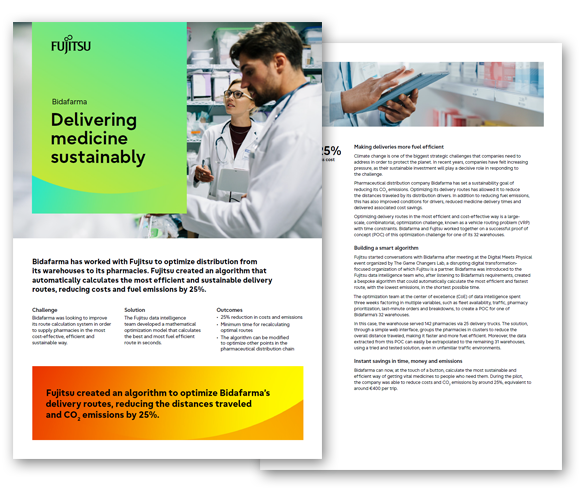Bidafarma has worked with Fujitsu to optimize distribution from its warehouses to its pharmacies. Fujitsu created an algorithm that automatically calculates the most efficient and sustainable delivery routes, reducing costs and fuel emissions by 25%.
Challenge
Bidafarma was looking to improve its route calculation system in order to supply pharmacies in the most cost-effective, efficient and sustainable way.
Solution
The Fujitsu data intelligence team developed a mathematical optimization model that calculates the best and most fuel efficient route in seconds.
Outcomes
- 25% reduction in costs and emissions
- Minimum time for recalculating optimal routes
- The algorithm can be modified to optimize other points in the pharmaceutical distribution chain
Fujitsu created an algorithm to optimize Bidafarma’s delivery routes, reducing the distances traveled and CO2 emissions by 25%.

25% less cost
25% reduction in emissions
- Industry: Logistics
- Location: Spain
- People: 1,700+
- Customer's website

About the customer
Bidafarma is a key link in the pharmaceutical distribution chain, providing medicines to over 10,000 pharmacies from its network of 32 warehouses.
Making deliveries more fuel efficient
Climate change is one of the biggest strategic challenges that companies need to address in order to protect the planet. In recent years, companies have felt increasing pressure, as their sustainable investment will play a decisive role in responding to the challenge.
Pharmaceutical distribution company Bidafarma has set a sustainability goal of reducing its CO2 emissions. Optimizing its delivery routes has allowed it to reduce the distances traveled by its distribution drivers. In addition to reducing fuel emissions, this has also improved conditions for drivers, reduced medicine delivery times and delivered associated cost savings.
Optimizing delivery routes in the most efficient and cost-effective way is a large scale, combinatorial, optimization challenge, known as a vehicle routing problem (VRP) with time constraints. Bidafarma and Fujitsu worked together on a successful proof of concept (POC) of this optimization challenge for one of its 32 warehouses.
Building a smart algorithm
Fujitsu started conversations with Bidafarma after meeting at the Digital Meets Physical event organized by The Game Changers Lab, a disrupting digital transformation focused organization of which Fujitsu is a partner. Bidafarma was introduced to the Fujitsu data intelligence team who, after listening to Bidafarma’s requirements, created a bespoke algorithm that could automatically calculate the most efficient and fastest route, with the lowest emissions, in the shortest possible time.
The optimization team at the center of excellence (CoE) of data intelligence spent three weeks factoring in multiple variables, such as fleet availability, traffic, pharmacy prioritization, last-minute orders and breakdowns, to create a POC for one of Bidafarma’s 32 warehouses.
In this case, the warehouse served 142 pharmacies via 25 delivery trucks. The solution, through a simple web interface, groups the pharmacies in clusters to reduce the overall distance traveled, making it faster and more fuel efficient. Moreover, the data extracted from this POC can easily be extrapolated to the remaining 31 warehouses, using a tried and tested solution, even in unfamiliar traffic environments.
Instant savings in time, money and emissions
Bidafarma can now, at the touch of a button, calculate the most sustainable and efficient way of getting vital medicines to people who need them. During the pilot, the company was able to reduce costs and CO2 emissions by around 25%, equivalent to around €400 per trip.
Bidafarma was also able to reduce the vehicle fleet from 25 to just 13 vehicles, with all the associated savings in maintenance that brings. Meanwhile, its internal logistics team has freed up considerable amounts of time to focus on more productive tasks.
The Bidafarma and Fujitsu algorithm can be tweaked to optimize other points of the pharmaceutical distribution chain in a context in which it is not enough to ensure transport capacity and meet delivery deadlines and frequencies. This also guarantees the products procured and supplied are genuine and correctly conserved. Minimal stock levels also need to be maintained to prevent shortages, taking into account expiry dates.








